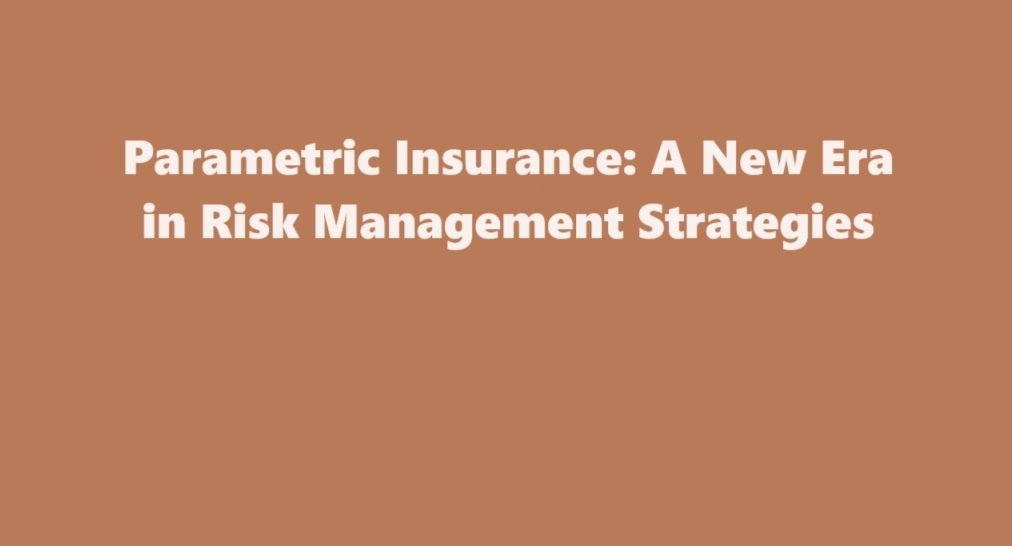Parametric Insurance: A New Era in Risk Management Strategies
Introduction
In a world of rapidly evolving risks and uncertainties, the traditional landscape of insurance is undergoing a revolutionary transformation. Parametric insurance has emerged as a groundbreaking approach, reshaping the way businesses and individuals manage and mitigate risks. This article delves into the intricacies of parametric insurance, examining its fundamental principles, diverse applications, and the profound impact it has on the landscape of risk management.
Disclaimer: This blog is solely for educational purposes.
Understanding Parametric Insurance
Definition and Distinctions
Parametric insurance marks a departure from traditional indemnity-based models. Rather than focusing on actual losses, parametric insurance relies on predefined parameters, or triggers, to determine payouts. This fundamental shift streamlines the claims process and introduces a new level of predictability.
Core Principles
Explore the core principles governing parametric insurance, emphasizing the importance of clear and measurable parameters. Discuss how the simplicity of this model facilitates faster claims processing and minimizes disputes.
Key Components and Parameters
Triggers and Indices
Examine the critical components of parametric insurance policies, such as triggers and indices. Triggers could be events like earthquakes, hurricanes, or floods, while indices may involve metrics like temperature, rainfall, or market indices.
Measurement Methods
Dive into the various measurement methods used to assess trigger parameters, including satellite data, weather stations, and technological innovations like IoT devices. Illustrate how advancements in technology enhance the accuracy of measurements.
Applications in Natural Disaster Coverage
Mitigating Risks
Highlight the role of parametric insurance in mitigating risks associated with natural disasters. Showcase how this model provides a proactive approach to risk management, allowing for swift response and recovery efforts.
Real-World Examples
Provide real-world examples of successful parametric insurance applications in disaster-prone regions. Share stories of communities and businesses that have benefited from timely and predictable payouts.
Parametric Insurance in Agriculture
Protecting Farmers
Examine how parametric insurance is revolutionizing risk management in agriculture. Discuss its role in safeguarding farmers against adverse weather conditions, ensuring financial stability even in the face of unpredictable events.
Quicker Payouts
Illustrate how parametric insurance expedites the claims process for farmers, offering quicker payouts based on objective parameters. Highlight the positive impact on agricultural sustainability.
Parametric Insurance Benefits for Businesses:
Speed and Transparency
Outline the advantages of parametric insurance for businesses, focusing on the speed and transparency it introduces to the claims process. Discuss how this can be particularly beneficial for industries with time-sensitive operations.
Customization
Explore how businesses can tailor parametric policies to align with specific risk exposures. Discuss the flexibility and customization options available, making it a versatile tool for diverse industries.
Emerging Trends and Technological Integration:
Data Analytics and IoT
Explore the latest trends in parametric insurance, emphasizing the integration of data analytics, IoT devices, and artificial intelligence. Discuss how these technological advancements enhance the accuracy and efficiency of parametric insurance products.
Future Innovations
Speculate on future innovations and developments in parametric insurance, considering the ongoing evolution of technology and data analytics. Discuss how these advancements may further refine the accuracy of trigger parameters.
Challenges and Considerations of Parametric Insurance
Data Accuracy
Address challenges associated with parametric insurance, such as the need for accurate data. Discuss how advancements in technology can help overcome this challenge, but also emphasize the importance of data quality.
Basis Risk
Explain the concept of basis risk and its potential impact on parametric insurance. Provide insights into how insurers and businesses can navigate this challenge through careful parameter selection and risk modeling.
Case Studies:
Real-World Success Stories: Present compelling case studies that showcase successful implementations of parametric insurance across various sectors. Highlight the tangible benefits experienced by businesses and communities.
Future Outlook
Growth and Evolution: Discuss the potential growth and evolution of parametric-insurance in the coming years. Consider how this innovative approach may play a crucial role in addressing emerging risks, such as those associated with climate change.
Read this article for more information: Pet Insurance Trends: Exploring the Evolving Landscape of Pet Insurance
Conclusion
Key Takeaways: Summarize the key takeaways, emphasizing the transformative impact of parametric insurance on risk management. Encourage businesses and individuals to explore this innovative approach to enhance their overall risk resilience.
In conclusion, parametric insurance stands as a beacon of innovation in the realm of risk management. By understanding its principles, applications, and ongoing developments, businesses and individuals can navigate the complex landscape of risks with newfound efficiency and confidence.
Reference: https://nidm.gov.in/PDF/pubs/WGR_NIDMandIII_2021.pdf
Disclaimer: This blog is solely for educational purposes.




